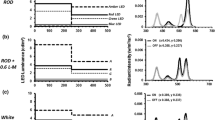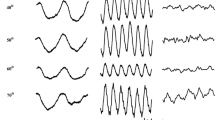Abstract
In the dog ERG flash-induced activation of the rod receptors can be selectively investigated due to relatively poor photic excitability of the cone component.
The ERG was produced in immobilized dogs using the method of Ganzfeld stimulation with white light flashes of 10 μsec duration. Relatively dim flashes ranging to about 100-fold above ERG threshold lead in the dark-adapted dog to selective activation of the rod receptors. This scotopic rod ERG consists of ERG positivity including ab wave with superimposed oscillations followed by a protracted potential, presumably thec wave.
Light flashes exceeding 100-fold threshold luminance cause simultaneous activation of rod and cone receptors. ERG characteristics include appearance of an early negativity, thea wave, followed byb andc waves of reduced amplitudes.
In the presence of a bright background luminance of 33 ftL bright light flashes cause an ERG resulting from selective cone activation. This photopic cone ERG consists of a smalla wave followed by a smallb wave with oscillatory potentials and by marked subsequent late negativity. With increase in background luminance the late negativity increases in amplitude and occurs progressively earlier.
The characteristics of the dog ERG allow selective assessment of functional changes in rod and cone receptors.
Similar content being viewed by others
References
R. Granit,The Components of the Retinal Action Potential in Mammals and their Relation to the Discharge in the Optic Nerve, J. Physiol., Lond.77, 207–239 (1933).
R.W. Rodieck,Components of the Electroretinogram — a Reappraisal, Vision Res.12, 773–780 (1972).
K.T. Brown andK. Watanabe,Isolation and Identification of a Receptor Potential from the Pure Cone Fovea of the Monkey Retina, Nature, Lond.193, 958–960 (1962).
R.F. Miller andJ.E. Dowling,Intracellular Responses of the Müller (Glial) Cells of Mudpuppy Retina: Their Relation to the b Wave of the Electroretinogram, J. Neurophysiol.33, 323–341 (1970).
J.E. Dowling,Organization of Vertebrate Retinas, Invest. Ophthalmol.9, 655–680 (1970).
J.C. Armington,The Electroretinogram, (Academic Press, N.Y., 1974).
R.H. Steinberg, R. Schmidt andK.T. Brown,Intracellular Responses to Light from Cat Pigment Epithelium: Origin of the Electroretinogram c Wave, Nature, Lond.227, 728–730 (1970).
V. Hrachovina,Schwellendichte elektronisch gemittelter Elektroretinogramme dunkel adaptierter Augen, Albrecht v. Graefes Arch. Ophthal.173, 192–198 (1967).
V. Hrachovina andB. Schmidt,Electroretinogram Fusion Frequency and Illumination of some Vertebrate Eyes, 6 ISCERG Symposium, 1967 (Georg Thieme, Leipzig, 1968), pp. 279–282.
U. Schaeppi andF. Liverani,Procedures for Routime Clinical Electroretinography (ERG) in Dogs, Agents and Actions7, 347–351 (1977).
U. Schaeppi andF. Liverani,Electroretinography as an Indicator of Toxic Retinopathy in Dogs. International Workshop on Pharmacological Methods in Preclinical Safety-Evaluation of New Drugs (Pergamon Press Oxford, in print).
D. Finkelstein, P. Gouras andM. Hoff,Human Electroretinogram Near the Absolute Threshold of Vision, Invest. Ophthalmol.7, 214–218 (1968).
P. Gouras,Electroretinography: Some Basic Principles, Invest. Ophthalmol.9, 557–569 (1970).
G. Niemeyer,Stäbchen und Zapfenktivität im klinischen Elektroretinogramm, Ophthalmologica, Basel172, 175–180 (1976).
G.D. Aguirre andL.F. Rubin,The Electroretinogram in Dogs with Inherited Cone Degeneration, Invest. Ophthalmol.14, 840–847 (1975).
H.B. Parry, K. Tansley andL.C. Thomson,The Electroretinogram of the Dog, J. Physiol., Lond.120, 28–40 (1953).
A.A. Genest,Oscillatory Potentials in the Electroretionogram of the Normal Human Eye, Vision Res.4, 595–604 (1964).
R. Granit andH.A. Riddell,The Electrical Responses of Light and Dark-Adapted Frogs' Eyes to Rhythmic and Continuous Stimuli, J. Physiol., Lond.81, 1–28 (1934).
Author information
Authors and Affiliations
Rights and permissions
About this article
Cite this article
Schaeppi, U., Liverani, F. Rod and cone components in the compound ERG of the beagle dog. Agents and Actions 9, 294–300 (1979). https://doi.org/10.1007/BF01966704
Received:
Issue Date:
DOI: https://doi.org/10.1007/BF01966704




